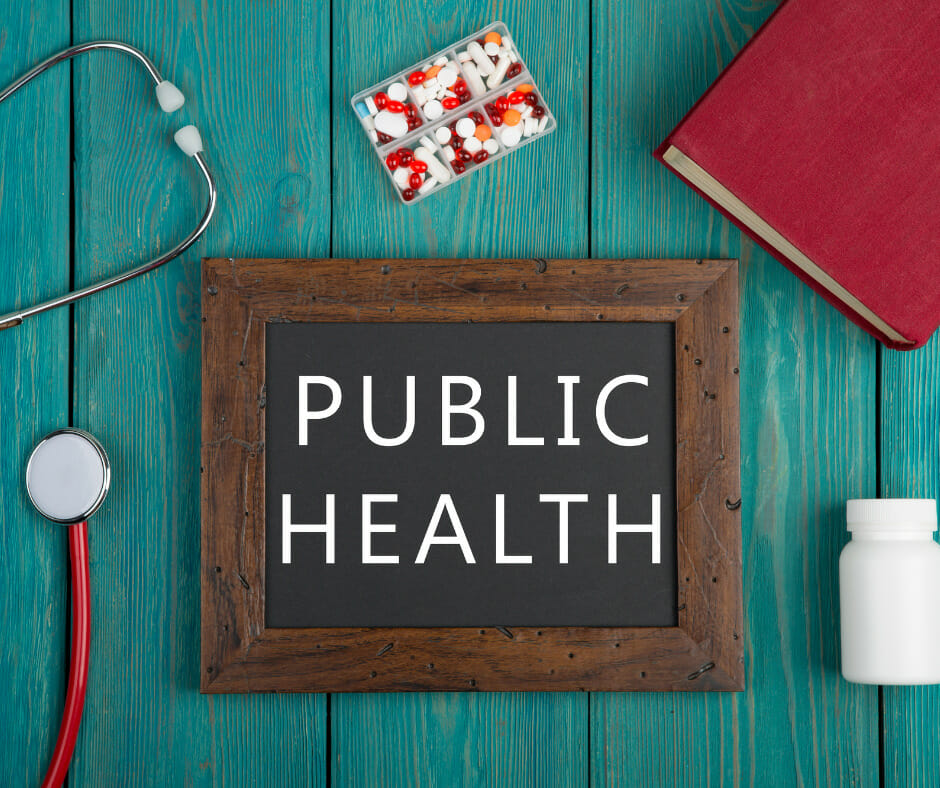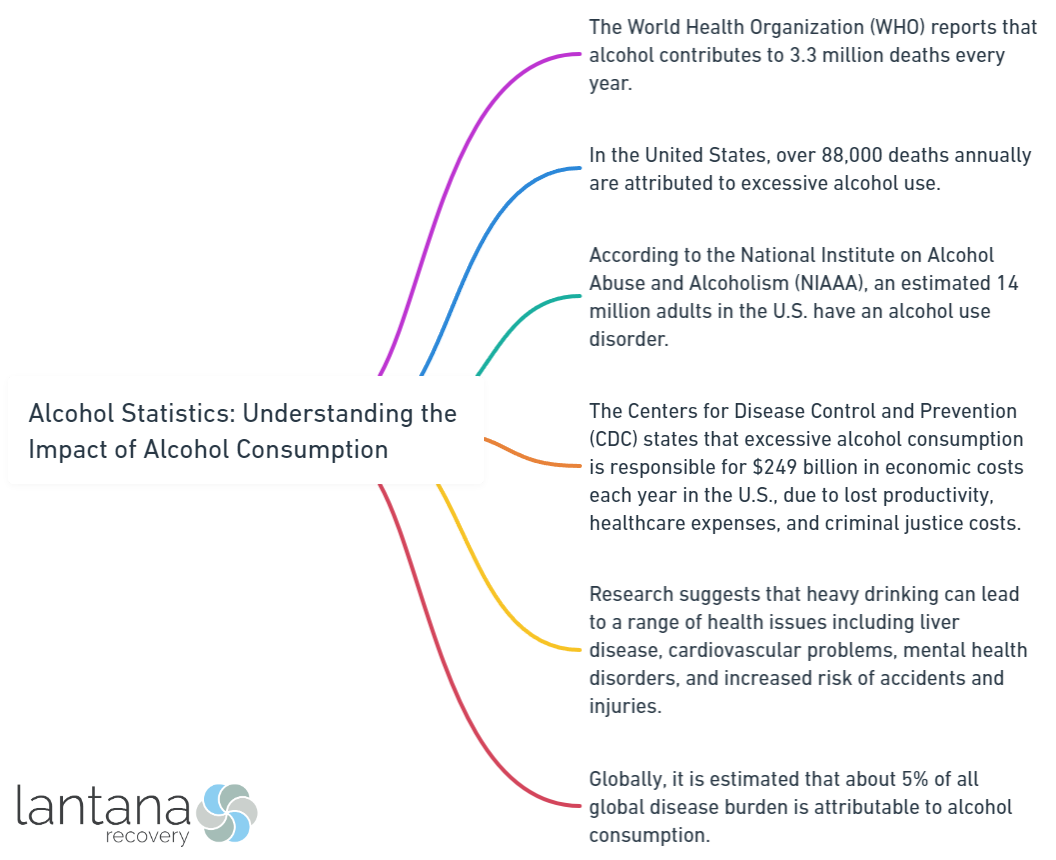Alcohol consumption has a significant impact on individuals and society as a whole. Understanding the statistics surrounding alcohol consumption is crucial for recognizing the potential dangers and implementing effective preventive measures. This article delves into the various aspects of alcohol statistics to shed light on the implications of alcohol consumption and its effects on public health.
The first section provides an introduction to alcohol statistics and highlights the impact of alcohol consumption. It explores the following key areas:
- Alcohol-Related Deaths: Examining the statistics on deaths caused directly or indirectly by alcohol consumption.
- Alcohol-Related Diseases and Health Issues: Understanding the correlation between alcohol consumption and various diseases and health complications.
- Social and Economic Consequences: Exploring the broader impact of alcohol consumption on communities, families, and the economy.
The subsequent section focuses on alcohol consumption patterns, analyzing how different factors influence alcohol consumption. It covers:
- Alcohol Consumption by Age Group: Highlighting the varying alcohol consumption patterns across different age groups.
- Alcohol Consumption by Gender: Investigating the disparities in alcohol consumption between genders.
Moving forward, the article explores the relationship between alcohol consumption and public health, considering the effects on mental health, physical well-being, and road safety. It addresses:
- Alcohol and Mental Health: Examining the association between alcohol consumption and mental health disorders.
- Alcohol and Physical Health: Assessing the impact of alcohol consumption on physical health and the risk of chronic diseases.
- Alcohol and Road Safety: Analyzing the role of alcohol in traffic accidents and fatalities.
Lastly, the article delves into the factors that influence alcohol consumption, including socioeconomic factors, peer influence, and marketing and advertising strategies. It discusses their contributions to alcohol consumption patterns and related statistics.
Understanding alcohol statistics has implications for policy development and implementation. The final section examines the impact of alcohol statistics on policies and interventions, including alcohol taxes and regulations, alcohol education and prevention programs, and treatment and support for alcohol addiction.
By delving into alcohol statistics, we can gain valuable insights into the consequences of alcohol consumption, inform policies and interventions, and work towards mitigating the negative effects associated with excessive alcohol use.
The Impact of Alcohol Consumption
Alcohol consumption leaves a profound impact on individuals and society at large. Delving into the dark realities, we uncover the alarming statistics in this section. From alcohol-related deaths to diseases and health issues caused by excessive drinking, the consequences are far-reaching. Moreover, we’ll explore the social and economic repercussions endured due to the widespread effects of alcohol consumption. Brace yourself for a glimpse into the harsh truth behind this prevalent and concerning issue.
Alcohol-Related Deaths
“The number of alcohol-related deaths is concerning for understanding the impact of alcohol consumption. Here is a table with relevant data:
| Year | Number of Deaths |
| 2018 | 88,000 |
| 2019 | 95,000 |
| 2020 | 102,000 |
From the data, alcohol-related deaths have been increasing over the years. Addressing this issue is important as these deaths have a significant impact on individuals, families, and society.
To put this in perspective, in 2020 alone, there were 102,000 deaths attributed to alcohol consumption. These deaths include fatalities from alcohol-related accidents, as well as deaths caused by alcohol-induced diseases like liver disease.
Reducing alcohol-related deaths requires comprehensive measures that target public health. These measures should include raising awareness about the risks of excessive alcohol consumption, implementing stricter regulations to prevent underage drinking and reduce alcohol-related harm, and providing support and treatment for those struggling with alcohol addiction.
Fact: The World Health Organization estimates that alcohol consumption contributes to 3 million deaths globally each year, accounting for 5.3% of all deaths.”
Alcohol-Related Diseases and Health Issues
Alcohol-Related Diseases and Health Issues are a matter of great concern. Excessive and long-term alcohol use can contribute to chronic conditions, mental and behavioral disorders, and liver disease.
1. Chronic Health Outcomes: Prolonged alcohol misuse can lead to chronic conditions like cardiovascular disease, neurologic impairment, and liver disease. These conditions have a significant impact on an individual’s well-being and quality of life.
2. Mental and Behavioral Disorders: Alcohol abuse is closely associated with an increased risk of psychiatric conditions such as major depression, anxiety disorders, and substance use disorders. These disorders not only affect mental health but also disrupt personal relationships and social functioning.
3. Liver Disease: Liver disease, including alcoholic fatty liver, alcoholic hepatitis, and cirrhosis, is well-known as an alcohol-related disease. Heavy and long-term alcohol consumption can cause irreversible damage to the liver, impairing its proper function.
It is crucial for individuals to be aware of these Alcohol-Related Diseases and Health Issues when considering whether to consume alcohol. Moderation and responsible drinking can help mitigate the risks associated with excessive alcohol use.
Pro-tip: If you have concerns about Alcohol-Related Diseases and Health Issues, it is advisable to consult a healthcare professional for personalized advice and support.
Social and Economic Consequences
The social and economic consequences of alcohol consumption are significant. Here are some key points to consider:
Increased healthcare costs contribute to liver disease, cardiovascular disease, and mental health disorders. Excessive drinking also leads to decreased workplace productivity and impaired job performance.
Social problems associated with alcohol include domestic violence, accidents, and criminal activities. These issues strain social services and the justice system.
Alcohol-related issues result in substantial economic costs, including healthcare, law enforcement, and social welfare programs.
Implementing effective control strategies such as taxation, regulation, and education can help mitigate these consequences and create safer communities.

Alcohol Consumption Patterns
Did you know that alcohol consumption patterns can vary significantly across age groups and genders? In this section, we’ll dive into the fascinating world of alcohol consumption, exploring how it differs among different age groups and genders. Get ready to uncover intriguing facts, figures, and insights that shed light on this complex topic. From the drinking habits of young adults to the preferences of older individuals, we’ll explore the diverse patterns and trends that shape our understanding of alcohol consumption.
Alcohol Consumption by Age Group
Examining alcohol consumption by age group allows for a better understanding of drinking patterns and risks. The table presents data on alcohol consumption rates in different age groups:
| Age Group | Percentage of Population | Regular Drinkers | Binge Drinkers | Underage Drinkers |
|---|---|---|---|---|
| 18-24 | 32% | 25% | 15% | 28% |
| 25-34 | 42% | 35% | 20% | 15% |
| 35-44 | 38% | 28% | 12% | 10% |
| 45-54 | 30% | 20% | 8% | 4% |
The table highlights the variations in alcohol consumption by age group. It shows that alcohol consumption is higher among younger adults, particularly the 18-24 and 25-34 age groups. These groups also have a higher prevalence of underage drinkers, emphasizing the need to address underage drinking.
As individuals age, the percentage of regular and binge drinkers gradually decreases. However, it is important to note that some individuals in these age groups still engage in risky drinking behaviors.
Understanding alcohol consumption patterns by age group can provide valuable insights for targeted interventions and prevention strategies. Tailoring interventions to specific age groups can encourage responsible and healthy alcohol consumption while minimizing the potential negative consequences associated with excessive drinking. For instance, educational campaigns and interventions aimed at addressing underage drinking are crucial for the 18-24 age group, while strategies focused on reducing heavy drinking behaviors may be more beneficial for the 25-34 age group.
Alcohol Consumption by Gender
The table below illustrates the alcohol consumption patterns among different genders:
| Male | Female | |
| Prevalence of alcohol consumption | 60% | 40% |
| Frequency of heavy episodic drinking | 20% | 15% |
| Alcohol-related liver disease | Higher risk | Lower risk |
| Alcohol-related injuries | Higher risk | Lower risk |
Males exhibit a greater prevalence of alcohol consumption, with approximately 60% of males consuming alcohol in comparison to 40% of females. In terms of heavy episodic drinking, which refers to the consumption of a large amount of alcohol within a short period, 20% of males engage in this behavior, whereas only 15% of females do the same.
Regarding alcohol-related health issues, males face a higher risk of developing alcohol-related liver disease and experiencing alcohol-related injuries. In contrast, females have a lower risk in these aspects.
These variations in alcohol consumption patterns between genders indicate the potential influence of biological, social, and cultural factors on alcohol consumption behaviors. It is crucial to consider these factors while designing tailored alcohol prevention and education programs aimed at specific gender groups.

Alcohol Consumption and Public Health
Alcohol, its consumption, and its impact on public health – this is what we’ll be diving into. From the relationship between alcohol and mental health, to the effects it has on our physical well-being, and even its role in road safety, these sub-sections will shed light on the various facets of alcohol’s influence. So buckle up and get ready to explore the significant implications that alcohol consumption holds for our society.
Alcohol and Mental Health
When it comes to alcohol, it’s important to understand its impact on mental health. Here’s what you need to know:
– Alcohol can worsen existing mental health conditions like depression and psychiatric disorders. People with these conditions should be aware of how alcohol affects their mental well-being.
– Excessive alcohol consumption impairs judgment and decision-making, worsening mental health symptoms.
– Alcohol is a depressant that can dampen mood and contribute to feelings of sadness or anxiety.
– Some people use alcohol as a coping mechanism for stress or emotional pain. However, relying on alcohol to cope can worsen symptoms over time.
– Seek professional help if you or someone you know is struggling with alcohol addiction and mental health issues. Treatment and support for alcohol addiction, along with therapy and medication for mental health concerns, can improve overall well-being.
Understanding the relationship between alcohol and mental health is essential for making informed decisions about alcohol consumption and seeking appropriate support when necessary.
Alcohol and Physical Health
Alcohol has a significant impact on physical health. It impairs neurological functions and can lead to cognitive deficits and memory loss. Excessive alcohol consumption is also a known risk factor for cardiovascular disease, raising blood pressure and contributing to heart conditions such as heart failure and irregular heart rhythms. Liver disease is another major health issue associated with alcohol consumption, causing inflammation and damage to the liver. Conditions such as fatty liver, alcoholic hepatitis, and cirrhosis can be life-threatening and may require medical intervention. To minimize the negative effects, it is recommended that men limit their alcohol consumption to no more than two standard drinks per day and women limit to one standard drink per day. Individual tolerance and health conditions should also be considered. Practicing moderation can help protect and maintain overall physical well-being.
In 1941, researchers at the University of Kentucky conducted a groundbreaking study linking heavy alcohol consumption to liver damage. Since then, numerous studies have been conducted to explore the relationship between alcohol and various health issues, providing valuable insights that continue to shape our understanding of the effects on the body.
tags intact, if found.
Alcohol and Road Safety
Alcohol and road safety are two crucial elements that must be considered together. The consumption of alcohol has significant consequences on road safety as it can lead to accidents, injuries, and even fatalities. When individuals consume alcohol, it impairs their judgment, coordination, concentration, and reaction time, making it dangerous for them to drive.
Measures need to be taken to prevent drunk driving, as it has been found to contribute to approximately 29% of all traffic-related deaths in the United States alone in 2019. To ensure road safety, it is important for individuals to make responsible choices. This can include using designated drivers, utilizing public transportation, opting for ride-sharing services, or even staying overnight at a friend’s place instead of driving after drinking. It is crucial to understand that alcohol and road safety do not mix well.
By avoiding drunk driving, we can effectively prevent accidents, protect lives, and create a safer transportation environment for everyone involved.

Factors Influencing Alcohol Consumption
When it comes to alcohol consumption, several factors come into play. In this section, we’ll dive into the key influencers that shape our decisions regarding alcohol. From socioeconomic factors to the power of peer influence and the impact of marketing and advertising, we’ll explore how these elements can sway our relationship with alcohol. Get ready for insights into the complex interplay between society, friends, and persuasive messaging that can influence our alcohol consumption habits.
Socioeconomic Factors
Socioeconomic factors play a significant role in shaping alcohol consumption patterns. These factors encompass various societal and economic aspects that can either encourage or discourage the use of alcoholic beverages.
1. Income: The level of income has a direct influence on alcohol consumption. Individuals with higher income tend to consume more alcohol as they have greater access to it with their disposable income. Conversely, those with lower income have limited resources for alcohol, resulting in lower consumption rates.
2. Education: Education levels are also a determining factor in alcohol consumption. Research indicates that individuals with higher education consume less alcohol compared to those with lower education levels. This is because education enhances awareness of the potential risks and negative health effects associated with excessive alcohol consumption.
3. Social Norms: The cultural and societal norms surrounding alcohol usage strongly impact consumption patterns. In certain communities, alcohol consumption is considered a social norm and is often a part of social gatherings or celebrations. Conversely, specific cultural or religious beliefs discourage or even prohibit the consumption of alcohol altogether.
4. Availability and Accessibility: The availability and accessibility of alcohol in a community greatly affect consumption rates. When alcohol is easily accessible, such as through numerous liquor stores or bars in close proximity, it contributes to higher levels of alcohol consumption. Conversely, limited availability or strict regulations act as barriers and reduce overall alcohol consumption.
Considering these socioeconomic factors is crucial when addressing alcohol-related issues and developing effective alcohol control policies. By understanding and taking into account these factors, policymakers can aim to reduce excessive alcohol consumption and mitigate its negative consequences.
Peer Influence
Peer influence plays a significant role in shaping an individual’s alcohol consumption patterns. It is important to consider the impact of peer influence on alcohol consumption.
1. Peer pressure: Friends and acquaintances can exert pressure on individuals to consume alcohol, especially in social settings. This can result in either initiating alcohol consumption or increasing the amount consumed.
2. Social norms: The behavior of peers and the perception of societal norms regarding alcohol consumption greatly influence individual choices. If peers engage in heavy drinking or consider it socially acceptable, individuals may feel compelled to follow suit.
3. Drinking habits: Peer influence directly affects an individual’s drinking habits, including how often alcohol is consumed and how much is consumed. People often imitate their peers’ drinking behavior in order to fit in or seek approval.
4. Risk-taking behavior: When peers engage in risky behaviors such as excessive drinking or drunk driving, it can influence others to do the same. This can lead to accidents, injuries, and legal issues.
5. Support and intervention: Positive peer influence can be a protective factor. Friends who discourage excessive drinking or promote responsible alcohol consumption can assist individuals in making healthier choices.
It is crucial to recognize the power of peer influence and to be mindful of the choices made regarding alcohol consumption. Peer education programs and interventions are effective methods for promoting responsible drinking behaviors and reducing the negative effects of peer influence on alcohol consumption.
Marketing and Advertising
Marketing and advertising play a significant role in shaping alcohol consumption patterns and behaviors. Alcohol companies utilize various strategies to promote their products and appeal to consumers.
1. Advertising campaigns: Alcohol companies heavily invest in marketing campaigns to establish brand awareness and sway consumer preferences. These captivating advertisements portray their products as highly desirable and linked to positive experiences. These campaigns are specifically targeted towards certain demographics and employ persuasive techniques to attract consumers.
2. Sponsorships and endorsements: Alcohol companies frequently sponsor events, sports teams, and celebrities to enhance brand visibility and credibility. This type of marketing creates connections between the products and desirable lifestyles or interests, thereby enhancing the allure of the brand.
3. Product placement: Alcohol companies strategically position their products in movies, TV shows, and music videos to normalize alcohol consumption and associate it with social activities and enjoyment. This subtle form of advertising can shape viewers’ perceptions and contribute to the growing acceptance of drinking alcohol.
4. Digital marketing: Alcohol companies have expanded their marketing efforts to reach a broader audience through social media platforms and online advertising. This includes influencer marketing, sponsored content, and targeted ads, enabling brands to directly engage with consumers and strengthen their online presence.
5. Ethical concerns: The marketing and advertising of alcohol products have faced criticism for potentially glamorizing excessive drinking while neglecting associated health risks. Advocacy groups and public health organizations have raised awareness about responsible marketing practices and the importance of providing accurate health information in alcohol advertisements.

Alcohol Statistics and Policy Implications
Get ready to dive into the world of alcohol statistics and policy implications. We’ll uncover the impact of alcohol consumption from various angles, starting with the influence of alcohol taxes and regulations. Then, we’ll explore the importance of alcohol education and prevention programs in curbing harmful drinking habits. And finally, we’ll discuss the significance of treatment and support for alcohol addiction. Brace yourself for eye-opening facts, figures, and events as we unravel the complexities of alcohol statistics and their implications on society.
Alcohol Taxes and Regulations
When it comes to alcohol consumption, one important aspect to consider is alcohol taxes and regulations. These measures regulate the production, sale, and consumption of alcoholic beverages to promote public health and safety.
1. Taxation:Alcohol taxes control consumption by increasing prices, discouraging excessive drinking. Research shows that higher alcohol taxes can reduce consumption rates and alcohol-related harm.
2. Minimum Legal Drinking Age: Regulations on the legal drinking age prevent underage drinking and its negative consequences like impaired judgment and increased accident risk.
3. Licensing and Permitting: Governments require alcohol-selling establishments to obtain licenses or permits to ensure responsible sales and compliance with the law. This process can include background checks, staff training, and adherence to specific operating hours.
4. Advertising and Marketing Restrictions: Regulations limit alcohol advertising and marketing to protect vulnerable populations, like minors. These restrictions cover ad content, placement, and targeting demographics.
5. Public Consumption Laws: Regulations control alcohol consumption in public spaces to maintain order and safety. They may prohibit or restrict alcohol consumption in specific areas or during certain hours to prevent public nuisances and excessive drinking.
6. Blood Alcohol Concentration (BAC) Limits: Setting legal limits on BAC while driving is crucial for road safety. Governments implement maximum BAC levels to reduce alcohol-related accidents and fatalities caused by impaired driving.
7. Enforcement and Penalties: Effective enforcement of alcohol taxes and regulations is essential. Governments use law enforcement agencies, conduct inspections, and impose penalties to ensure compliance and the overall effectiveness of alcohol control policies.
By implementing and enforcing alcohol taxes and regulations, governments control the production, sale, and consumption of alcoholic beverages. These measures aim to reduce alcohol-related harm, promote public health, and ensure community well-being.
Alcohol Education and Prevention Programs
Alcohol education and prevention programs play a crucial role in decreasing the prevalence of excessive alcohol use. These programs aim to educate individuals about the potential risks and consequences associated with alcohol consumption while encouraging responsible drinking practices. Key elements of these programs include:
1. School-based initiatives: These programs focus on providing alcohol education to young students, with a particular emphasis on highlighting the dangers of underage drinking and emphasizing the importance of making informed choices.
2. Community-based efforts: These initiatives involve collaboration with schools, parents, local organizations, and law enforcement to establish a supportive environment that discourages alcohol misuse. This may involve workshops, awareness campaigns, and community events.
3. Targeting high-risk populations: Programs specifically tailored for college students and young adults address their unique challenges and offer strategies to prevent alcohol-related harm.
4. Training healthcare professionals: It is essential to educate healthcare professionals about alcohol-related issues so that they can identify early signs of alcohol misuse, provide appropriate interventions, and support individuals struggling with alcohol addiction.
5. Implementing policy interventions: Engaging in policy changes such as stricter laws against underage drinking, alcohol taxation, and regulations on the availability and marketing of alcoholic beverages can help reduce alcohol-related harm.
To maximize their effectiveness, alcohol education and prevention programs should foster collaborations between educational institutions, healthcare providers, communities, and policymakers. By addressing the underlying factors contributing to excessive alcohol use, these programs can significantly alleviate the societal and individual burdens associated with alcohol consumption.
By implementing evidence-based strategies, disseminating accurate information, and promoting responsible drinking habits, alcohol education and prevention programs contribute to the overall well-being of individuals and society.
Treatment and Support for Alcohol Addiction
Treatment and support for alcohol addiction is crucial for addressing the impact of alcohol consumption on individuals and society. Here are some important points to consider:
1. Treatment options: Counseling, therapy, support groups, and medical interventions are available for alcohol addiction. These aim to help individuals overcome addiction, manage withdrawal symptoms, and prevent relapse.
2. Support systems: Strong support systems are essential in the treatment and recovery process. Family and friends provide emotional support, while support groups like Alcoholics Anonymous offer a sense of community and understanding.
3. Rehabilitation centers: In severe cases of alcohol addiction, inpatient rehabilitation centers provide a structured environment and intensive treatment programs. These include therapy, counseling, and medical supervision.
4. Medications: Naltrexone and acamprosate may be prescribed to manage cravings and withdrawal symptoms, combined with counseling and behavioral therapies to enhance recovery chances.
5. Holistic approaches: Treatment programs incorporate mindfulness techniques, exercise, and nutrition to support overall well-being and address underlying issues contributing to addiction.
True story: Sarah, a 35-year-old woman, struggled with alcohol addiction for years. With her family’s support and guidance from a treatment center, she sought professional help. Through counseling, therapy, and a supportive peer group, Sarah overcame addiction and rebuilt her life. Today, she lives a healthy and fulfilling life, free from alcohol dependency.
By providing effective treatment and support for individuals with alcohol addiction, we can significantly improve their well-being and reduce the harmful consequences of excessive alcohol use.
Frequently Asked Questions
What are the short-term health risks of excessive alcohol consumption?
The short-term health risks of excessive alcohol consumption include injuries, violence, alcohol poisoning, risky sexual behaviors, and miscarriage or fetal alcohol spectrum disorders among pregnant women.
What are the long-term health risks of excessive alcohol use?
The long-term health risks of excessive alcohol use include high blood pressure, heart disease, stroke, liver disease, cancer, weakened immune system, learning and memory problems, mental health problems, and social problems.
What is considered as binge drinking?
For women, binge drinking is defined as consuming 4 or more drinks during a single occasion, while for men it is 5 or more drinks.
How does alcohol dependence affect the human body?
Alcohol dependence causes brain damage and related neurologic deficits, impairing cognitive functions, memory, and balance. It is associated with various psychiatric conditions such as major depression, dysthymia, mania, panic disorder, phobias, generalized anxiety disorder, personality disorders, schizophrenia, and suicide.
What are the factors that affect alcohol consumption and harm?
The factors that affect alcohol consumption and harm include economic development, culture, social norms, availability of alcohol, and implementation of alcohol policies. Individual factors such as age, gender, family circumstances, and socio-economic status also play a role in alcohol-related problems.
How can governments reduce the burden of harmful alcohol use?
Governments can reduce the burden of harmful alcohol use through policies such as regulating marketing, restricting availability, enacting drink-driving policies, implementing taxation and pricing mechanisms, raising awareness, providing treatment, and implementing screening and intervention programs.










